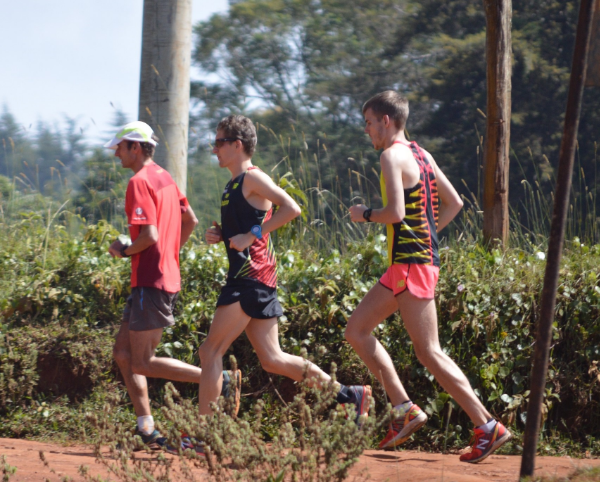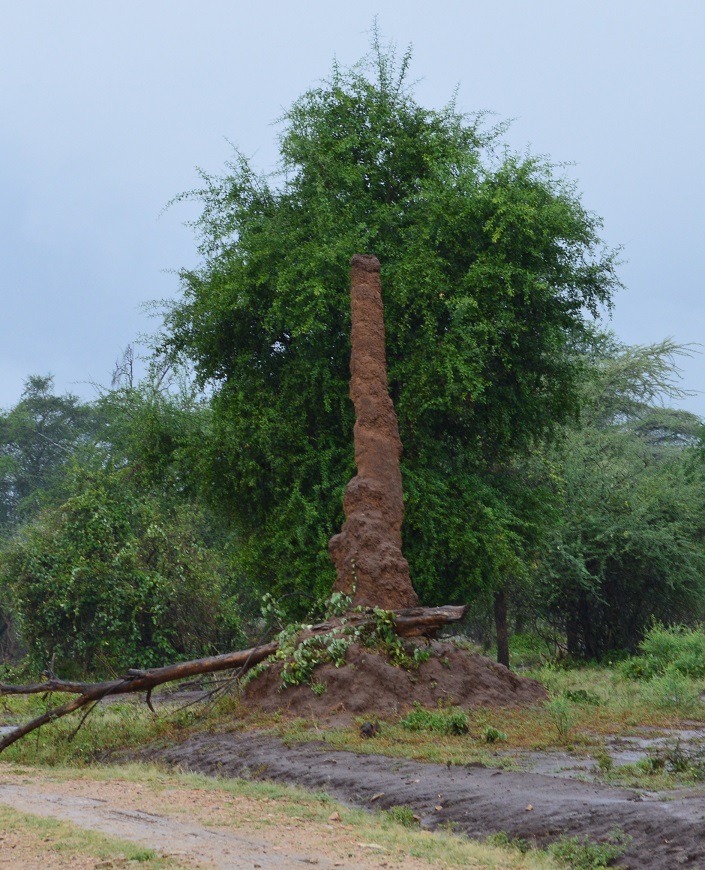Nandi County, the Source of Champions is written large on the sign that marks the division from Uasin Gishu County. Justin is taking me, along with his wife and daughter, to meet his family at Kapkeringon Village.
The sign also marks the last time the vehicle touches asphalt as we take a fast right on to a rough dirt road. The red clay and the embedded rock remind me of the drive that we used to do to my wife’s parents house in Dulzura, CA. She hated that road. She wouldn’t have like this one any better as it was nearly twenty miles of rough travel, often dodging motorcycles and pedestrians. I was fortunate to only bounce off the ceiling once – the trials of the over-tall.
Kapkeringon Village sits a bit higher than Eldoret. Justin pointed out to the distance to show me when I asked. As with my current neck of the woods, the air is clear enough that trees are clearly visible from miles away. More on the trees later, by the way.
The home where Justin’s mother lives, his father just very recently having passed away, sits atop a hill with view of the surrounding countryside. The wattle and daub home itself is traditional, which in this part of Kenya means that there is no electricity or running water. The roof is corrugated tin. The floor was dirt but looked as though it were a chocolaty brush velvet.
Justin’s family joined in for the visit. One somewhat discomfiting problem is that I seem to be the only white guy that has visited some of these areas, so I’ve been attracting attention just for that, with children literally running next to the car to see the mzungu. The family, though, could not have been more welcoming.
Thanks to Celia, I ask Justin if we could bring a gift for his mother. We stopped at a market on the way and picked up sugar and flour, appropriate gifts for the visit. I didn’t know that later we would visit a second home and didn’t have a gift then. Hopefully, I will be able to rectify my lack of manners soon.
Unlike the other visits that I have made so far to homes, tea was not served. Instead, fresh milk, made in the Nandi way, was. Absolutely delicious, rich with the creams that we normally see separated out in our milk. There was also a black residue that comes from lining the interior of the gourd with ash which apparently helps seal the gourd and to preserve the milk.
Also served was mursik, a fermented milk. This had a tarter taste and a thicker composition. Justin’s mom put me on the spot and asked which I preferred. I said the fresh milk. That might have been a bit of a faux pas. Oops.
While we waited for the meal, several of the men of the family – the women were cooking and watching the young ones – proceed to grill me on all things American, supposing that I had all the answers. I was impressed by the depth of the questions they asked and on the wide range of things that captured their curiosity.
That we had free public schooling through the twelfth grade (once we got around the differences in the English system of forms versus grades) was revolutionary. The idea that students would drop out rather than complete their schooling seemed scandalous. Home schooling as an option seemed equally inconceivable to them.
We spent quite a bit of time on agriculture, not surprising given they, as a family, run a farm. The Nandi (and the Massai, too) treated their cattle as part of the family, to the extent of naming them so that they will come when called. I gave them our version of factory produced beef. The men were less than impressed. I understood.
They laughed at my joke that the American food industry was trying to kill me. They nodded in affirmation when I told them that I grew my own vegetables when I could. I neglected to mention that I ‘let’ the deer eat it this year.
Vehicles, roads, driving in snow, exactly which Washington I was from, book pricing, university education, and a host of other topics were touched on. It was a most pleasant, if exhausting, conversation.
Food was served, chapata, meat (chicken), potatoes, stewed leafy greens that had a bit of bite to them, and tea. Millet came later, along with more mursik.
The Kenyans have a really nice custom of bringing warm water in a jug with a pan to the people eating. The water is poured over the hands so that you can wash the dust of the fields or your travels from your hands before eating. The whole ceremony of the washing is very comforting at a visceral level.
After eating, we walked out to the yard. I meandered, taking pictures of the hillsides, much more green than I expected and looking at their expansive and well-tended garden. Justin pulled me aside to point out where his school lay.
We couldn’t see it. The trees were in the way. Three or four times during the course of the day, some would point and mention a place across a valley or up a hill, and finished by saying, “Just behind the trees.”
The trees in question are eucalyptus trees. In the last two decades, they’ve begun to completely reform the landscape. They are also not so slowly squeezing out the native trees. They grew very well in the high altitude environment and spread quickly. It will be interesting to see the changes that the increased vegetation brings to the county.
The crops here changed as well. Formerly a major coffee producing region, the main cash crop now is maize. That’s starting to change but getting the new coffee plants requires capital. The changeover will take years.
When Justin and I returned to the group, I discovered I was now the photographer and began to take family pictures for them. Lots of smiles from the adults. The kids, not so much. I’ve asked Justin to get one of the group pictures printed and then identify every one – I could not keep track of all of the names.
Afterwards, we headed back out, stopping to visit Caro Ronoh and her family. Her husband, a physics and chemistry teacher, was fascinating to talk to. In the Kenyan educational system, the teachers often get reassigned to schools sometimes a hundred kilometers (~62 miles), making life very difficult for them and the families. They have been fortunate to be in the same location for 22 years.
Caro served a dish similar to donuts minus the excess sugar, very tasty, and tea. Kenyan tea is not the stuff that you see Lipton put out. They heat the milk and water at the same time and brew using tea leaves, then add sugar. It’s quite delicious.
We enjoyed the refreshments and then traipsed outside. A tough looking hill sat about a half-mile away. That hill was used for years for training. The Nandi athletes would measure themselves against the hill, building leg strength and stamina. More importantly, as Henry Rono points out in his book, Olympic Dream, it builds courage.
Every place you visit in the county seems to have the same types of stories, of the hard work of the athletes and their families, that built them into champions. True, they have great distance-running genetics. True, they have mursik (suggested to be a source of their prowess.) Mostly, though, they learn to work hard, early in life, and carry that forward with them.
The trip home was quiet. Justin asked if I was falling asleep. I assured him I wasn’t, just thinking about the book I want to write. Thanks to Justin and his family, I know what my opening scene is. Hopefully, when I start that novel, I’ll be able to do it justice.


























































